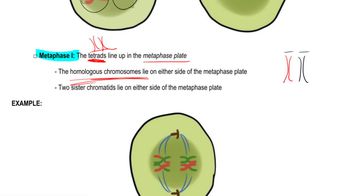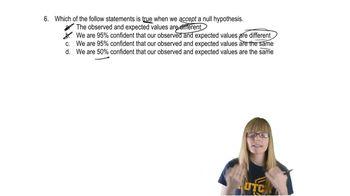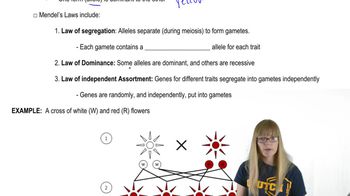Table of contents
- 1. Introduction to Genetics51m
- 2. Mendel's Laws of Inheritance3h 37m
- 3. Extensions to Mendelian Inheritance2h 41m
- 4. Genetic Mapping and Linkage2h 28m
- 5. Genetics of Bacteria and Viruses1h 21m
- 6. Chromosomal Variation1h 48m
- 7. DNA and Chromosome Structure56m
- 8. DNA Replication1h 10m
- 9. Mitosis and Meiosis1h 34m
- 10. Transcription1h 0m
- 11. Translation58m
- 12. Gene Regulation in Prokaryotes1h 19m
- 13. Gene Regulation in Eukaryotes44m
- 14. Genetic Control of Development44m
- 15. Genomes and Genomics1h 50m
- 16. Transposable Elements47m
- 17. Mutation, Repair, and Recombination1h 6m
- 18. Molecular Genetic Tools19m
- 19. Cancer Genetics29m
- 20. Quantitative Genetics1h 26m
- 21. Population Genetics50m
- 22. Evolutionary Genetics29m
2. Mendel's Laws of Inheritance
Mendel's Experiments and Laws
Problem 6b
Textbook Question
An organism has alleles R₁ and R₂ on one pair of homologous chromosomes, and it has alleles T₁ and T₂ on another pair. Diagram these pairs of homologs at the end of metaphase I, the end of telophase I, and the end of telophase II, and show how meiosis in this organism produces gametes in expected Mendelian proportions. Assume no crossover between homologous chromosomes.
 Verified step by step guidance
Verified step by step guidance1
**Step 1: Understand the Chromosome Setup** - The organism has two pairs of homologous chromosomes. One pair carries alleles R₁ and R₂, and the other pair carries alleles T₁ and T₂. At the start of meiosis, each chromosome is duplicated, resulting in sister chromatids.
**Step 2: Diagram at the End of Metaphase I** - During metaphase I, homologous chromosomes align at the metaphase plate. Diagram the homologous pairs: (R₁R₁) aligned with (R₂R₂) and (T₁T₁) aligned with (T₂T₂).
**Step 3: Diagram at the End of Telophase I** - At the end of telophase I, the homologous chromosomes are separated into two different cells. One cell will have (R₁R₁) and (T₁T₁), and the other will have (R₂R₂) and (T₂T₂).
**Step 4: Diagram at the End of Telophase II** - In telophase II, sister chromatids separate, resulting in four cells. Each cell will have one of the following combinations: R₁T₁, R₁T₂, R₂T₁, R₂T₂.
**Step 5: Explain Gamete Formation** - The four gametes produced will have the combinations R₁T₁, R₁T₂, R₂T₁, and R₂T₂, each in equal proportions, demonstrating Mendelian inheritance without crossover.
Recommended similar problem, with video answer:
 Verified Solution
Verified SolutionThis video solution was recommended by our tutors as helpful for the problem above
Video duration:
2mPlay a video:
Was this helpful?
Key Concepts
Here are the essential concepts you must grasp in order to answer the question correctly.
Homologous Chromosomes
Homologous chromosomes are pairs of chromosomes in a diploid organism that have the same structure and gene sequence but may carry different alleles. Each parent contributes one chromosome to the pair, resulting in two copies of each gene. During meiosis, these chromosomes segregate to ensure that gametes receive only one allele from each pair, which is crucial for understanding genetic variation in offspring.
Recommended video:
Guided course

Chromosome Structure
Meiosis Stages
Meiosis consists of two rounds of cell division: meiosis I and meiosis II. In meiosis I, homologous chromosomes are separated, while in meiosis II, sister chromatids are separated. At the end of metaphase I, homologs align at the equatorial plane, and by the end of telophase II, four haploid gametes are produced, each containing a unique combination of alleles due to independent assortment.
Recommended video:
Guided course

Meiosis Steps
Mendelian Proportions
Mendelian proportions refer to the predictable ratios of genotypes and phenotypes in offspring resulting from genetic crosses, as described by Gregor Mendel's laws of inheritance. In this case, the alleles R₁, R₂, T₁, and T₂ will assort independently during meiosis, leading to gametes that can combine in various ways, typically resulting in a 1:2:1 ratio for heterozygous crosses and a 9:3:3:1 ratio for dihybrid crosses.
Recommended video:
Guided course

Step 6

 8:06m
8:06mWatch next
Master Mendel's Experiments with a bite sized video explanation from Kylia Goodner
Start learningRelated Videos
Related Practice



